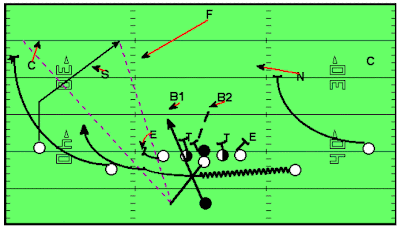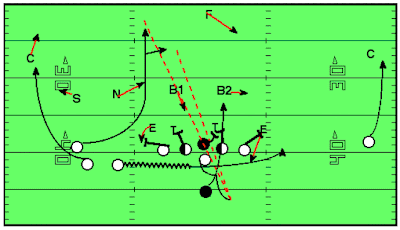Part 2 - Run Game and Play passes
The general makeup of the offense includes a run game, play passes, drop-back passing attack and exotics. The following is an overview of each area of the offense:
Run Game
This aspect of the offense is broken up into the Belly series, Trap series and Dive series. Our linemen work daily on their zone, veer, trap and double team blocks in order to maximize our consistency in rushing the ball.
The primary series of the offense is the Belly series, which is influenced by triple option (Hambone) and zone blocking. This was also complimented by a backfield action that I was able to glean from “Dutch” Meyers book, Spread Formation Football (albeit, he did this out of the shotgun) and some basic Wing-T concepts. The Belly series consists of the Pop Out (I have heard it also called the Jet or Fly Sweep) and the following dive plays, Veer and Zone as well as the change-up plays of the Option and Reverse. The key in executing each of these aspects of the Belly series is in the actual “ride” of the motion receiver by the QB and the subsequent fake or hand-off to the Superback, in order to draw attention to the potential Pop Out around the edge or the dive play to the back. Ideally, our Pop Out and dive plays will look the same for the first 3 steps and then become the actual play called prior to the snap of the ball. The change-up plays of Option and Reverse are designed to take advantage of fast flowing linebackers and defensive line slants.
Pop Out

Zone

Veer

Option

Reverse

Play Passes
The key to the play pass is that for the first three steps of the run series associated with it, the backfield and blocking must stay consistent (Bill Walsh). I know we are coming along when we stop the video at this point and we are not be able to tell if it is a run or a pass. Play Passes are called when the secondary is rolling or linebackers are so keyed-in to the run series that they disregard the potential of a pass over the top.
Our base play passes are executed off of our top run series, the Belly series. We practice two primary play passes, one to the front side (Wheel) and one to the backside (Switch). Regarding play pass protection, we put the Superback on the front side linebacker as we fake the Pop Out play and all the other linemen are aggressive in their execution of selling the run play.
Even Wheel
The Wheel is run out of our Even (balanced) formation and this play is good versus Nickel or Dime coverage. The play begins with the inside receiver coming in motion, the QB will then ride the receiver on a Pop Out fake as he turns to the oncoming receiver. The action will continue with a fake to the Superback. The QB will then set up just outside the play-side Guard and throw the Wheel combination. The QB will look to throw the ball to the Post first, then to the Wheel up the boundary. Often times the Wheel is thrown to the back shoulder of the receiver.
Receivers will take their first 3 steps (as if stalk blocking) and then break into their routes. The outside play-side receiver will break on a Post (5th Step) while the inside receiver will run through the breakpoint of the Post route.

Load Switch
The Switch route is run out of one of our trips formations (Rip or Load) and this play is also good versus Nickel or Dime coverage. The play begins with the number 3 receiver backside coming in motion for the Pop Out fake. The QB will simulate the same action as he did in Wheel. This time he will look backside to the Stretch route, which is running up inside the backside hash mark.
The two backside receivers will run the Switch combination on the backside in the following manner. The outside receiver backside will come first and get inside the hash mark at a point 7 yards up field while the number 2 receiver will run through the point where the outside receiver crossed his face and he will continue up the sideline. The outside receiver is responsible to read the deep zone defender over him. If that man is a Cover 3 safety, that defender may run downhill to tackle the Pop Out and if he does that, the receiver will continue on a thin post. If he stays high over the top, then the receiver will break his route flat at a depth of 12 yards to get open underneath the free safety. The Cover 2 conversion is predicated on the action of the backside safety. If he rolls to Cover 3, then the receiver will apply his Cover 3 rules. If he stays on the hash mark, the receiver will break it flat at 12 yards.
The QB will look to the backside Stretch route adjustment first and then to the route up the boundary. The boundary route is often times a back shoulder throw.

[Ed. Note. For more on the "switch" concept, see here.]
Play passes are often adjusted as we get through the season to take advantage of how defenses are geared up to slow down our Belly series.
Tomorrow, an overview of the dropback passing game.
- Manny Matsakis